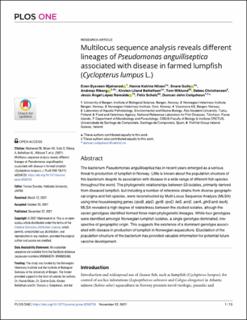| dc.contributor.author | Mjølnerød, Even Bysveen | |
| dc.contributor.author | Nilsen, Hanne Katrine | |
| dc.contributor.author | Gulla, Snorre | |
| dc.contributor.author | Riborg, Andreas Ekroll | |
| dc.contributor.author | Bottolfsen, Kirsten | |
| dc.contributor.author | Wiklund, Tom | |
| dc.contributor.author | Christiansen, Debes | |
| dc.contributor.author | Romalde López, Jesús Ángel | |
| dc.contributor.author | Scholz, Felix | |
| dc.contributor.author | Colquhoun, Duncan John | |
| dc.date.accessioned | 2022-03-24T08:57:05Z | |
| dc.date.available | 2022-03-24T08:57:05Z | |
| dc.date.created | 2022-01-11T12:10:14Z | |
| dc.date.issued | 2021 | |
| dc.identifier.issn | 1932-6203 | |
| dc.identifier.uri | https://hdl.handle.net/11250/2987230 | |
| dc.description.abstract | The bacterium Pseudomonas anguilliseptica has in recent years emerged as a serious threat to production of lumpfish in Norway. Little is known about the population structure of this bacterium despite its association with disease in a wide range of different fish species throughout the world. The phylogenetic relationships between 53 isolates, primarily derived from diseased lumpfish, but including a number of reference strains from diverse geographical origins and fish species, were reconstructed by Multi-Locus Sequence Analysis (MLSA) using nine housekeeping genes (rpoB, atpD, gyrB, rpoD, ileS, aroE, carA, glnS and recA). MLSA revealed a high degree of relatedness between the studied isolates, altough the seven genotypes identified formed three main phylogenetic lineages. While four genotypes were identified amongst Norwegian lumpfish isolates, a single genotype dominated, irrespective of geographic origin. This suggests the existence of a dominant genotype associated with disease in production of lumpfish in Norwegian aquaculture. Elucidation of the population structure of the bacterium has provided valuable information for potential future vaccine development. | en_US |
| dc.language.iso | eng | en_US |
| dc.publisher | Public Library of Science | en_US |
| dc.rights | Navngivelse 4.0 Internasjonal | * |
| dc.rights.uri | http://creativecommons.org/licenses/by/4.0/deed.no | * |
| dc.title | Multilocus sequence analysis reveals different lineages of Pseudomonas anguilliseptica associated with disease in farmed lumpfish (Cyclopterus lumpus L.) | en_US |
| dc.type | Journal article | en_US |
| dc.type | Peer reviewed | en_US |
| dc.description.version | publishedVersion | en_US |
| dc.rights.holder | Copyright 2021 Mjølnerød et al. | en_US |
| dc.source.articlenumber | e0259725 | en_US |
| cristin.ispublished | true | |
| cristin.fulltext | original | |
| cristin.qualitycode | 1 | |
| dc.identifier.doi | 10.1371/journal.pone.0259725 | |
| dc.identifier.cristin | 1978237 | |
| dc.source.journal | PLOS ONE | en_US |
| dc.identifier.citation | PLOS ONE. 2021, 16 (11), e0259725. | en_US |
| dc.source.volume | 16 | en_US |
| dc.source.issue | 11 | en_US |

